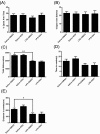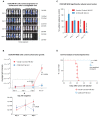Resveratrol counteracts lipopolysaccharide-induced depressive-like behaviors via enhanced hippocampal neurogenesis
- PMID: 27517628
- PMCID: PMC5302895
- DOI: 10.18632/oncotarget.11178
Resveratrol counteracts lipopolysaccharide-induced depressive-like behaviors via enhanced hippocampal neurogenesis
Abstract
Radial glial-like cells (RGLs) in the adult dentate gyrus (DG) function as progenitor cells for adult hippocampal neurogenesis, a process involved in the stress-related pathophysiology and treatment efficiency of depression. Resveratrol (RSV) has been demonstrated to be a potent activator of neurogenesis. The present study investigated whether chronic RSV treatment has antidepressant potential in relation to hippocampal neurogenesis. Mice received two weeks of RSV (20 mg/kg) or dimethylsulfoxide (DMSO) treatment, followed by lipopolysaccharide (LPS; 1 mg/kg) or saline injections for 5 days. We found that RSV treatment abrogated the increased immobility in the forced swimming test and tail suspension test induced by LPS. Immunohistochemical staining revealed that RSV treatment reversed the increase in microglial activation and the inhibition in DG neurogenesis. RSV treatment also attenuated LPS-induced defects in the expanding of RGLs through promoting symmetric division. In addition, RSV ameliorated LPS-induced NF-κB activation in the hippocampus coincides with the up-regulation levels of Sirt1 and Hes1. Taken together, these data indicated that RSV-induced Sirt1 activation counteracts LPS-induced depression-like behaviors via a neurogenic mechanism. A new model to understand the role of RSV in treating depression may result from these findings.
Keywords: LPS; Pathology Section; depression; neurogenesis; radial glial cells; resveratrol.
Conflict of interest statement
The authors have no competing financial interests.
Figures








References
-
- Sobocki P, Jonsson B, Angst J, Rehnberg C. Cost of depression in Europe. J Ment Health Policy Econ. 2006;9:87–98. - PubMed
-
- Sarkisova K, van Luijtelaar G. The WAG/Rij strain: a genetic animal model of absence epilepsy with comorbidity of depression. Prog Neuropsychopharmacol Biol Psychiatry. 2011;35:854–876. - PubMed
MeSH terms
Substances
LinkOut - more resources
Full Text Sources
Other Literature Sources
Medical

